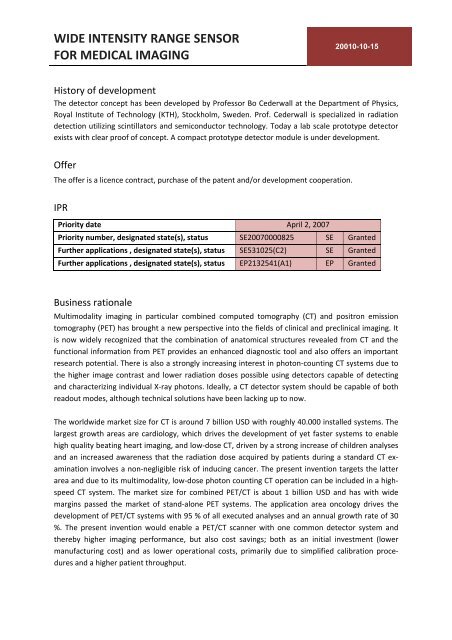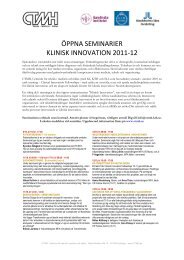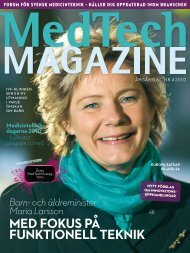Visualisering av funktionell och morfologisk hjärt-kärl-diagnostik
Visualisering av funktionell och morfologisk hjärt-kärl-diagnostik
Visualisering av funktionell och morfologisk hjärt-kärl-diagnostik
Create successful ePaper yourself
Turn your PDF publications into a flip-book with our unique Google optimized e-Paper software.
WIDE INTENSITY RANGE SENSOR<br />
FOR MEDICAL IMAGING<br />
20010-10-15<br />
History of development<br />
The detector concept has been developed by Professor Bo Cederwall at the Department of Physics,<br />
Royal Institute of Technology (KTH), Stockholm, Sweden. Prof. Cederwall is specialized in radiation<br />
detection utilizing scintillators and semiconductor technology. Today a lab scale prototype detector<br />
exists with clear proof of concept. A compact prototype detector module is under development.<br />
Offer<br />
The offer is a licence contract, purchase of the patent and/or development cooperation.<br />
IPR<br />
Priority date April 2, 2007<br />
Priority number, designated state(s), status SE20070000825 SE Granted<br />
Further applications , designated state(s), status SE531025(C2) SE Granted<br />
Further applications , designated state(s), status EP2132541(A1) EP Granted<br />
Business rationale<br />
Multimodality imaging in particular combined computed tomography (CT) and positron emission<br />
tomography (PET) has brought a new perspective into the fields of clinical and preclinical imaging. It<br />
is now widely recognized that the combination of anatomical structures revealed from CT and the<br />
functional information from PET provides an enhanced diagnostic tool and also offers an important<br />
research potential. There is also a strongly increasing interest in photon‐counting CT systems due to<br />
the higher image contrast and lower radiation doses possible using detectors capable of detecting<br />
and characterizing individual X‐ray photons. Ideally, a CT detector system should be capable of both<br />
readout modes, although technical solutions h<strong>av</strong>e been lacking up to now.<br />
The worldwide market size for CT is around 7 billion USD with roughly 40.000 installed systems. The<br />
largest growth areas are cardiology, which drives the development of yet faster systems to enable<br />
high quality beating heart imaging, and low‐dose CT, driven by a strong increase of children analyses<br />
and an increased awareness that the radiation dose acquired by patients during a standard CT ex‐<br />
amination involves a non‐negligible risk of inducing cancer. The present invention targets the latter<br />
area and due to its multimodality, low‐dose photon counting CT operation can be included in a high‐<br />
speed CT system. The market size for combined PET/CT is about 1 billion USD and has with wide<br />
margins passed the market of stand‐alone PET systems. The application area oncology drives the<br />
development of PET/CT systems with 95 % of all executed analyses and an annual growth rate of 30<br />
%. The present invention would enable a PET/CT scanner with one common detector system and<br />
thereby higher imaging performance, but also cost s<strong>av</strong>ings; both as an initial investment (lower<br />
manufacturing cost) and as lower operational costs, primarily due to simplified calibration proce‐<br />
dures and a higher patient throughput.




